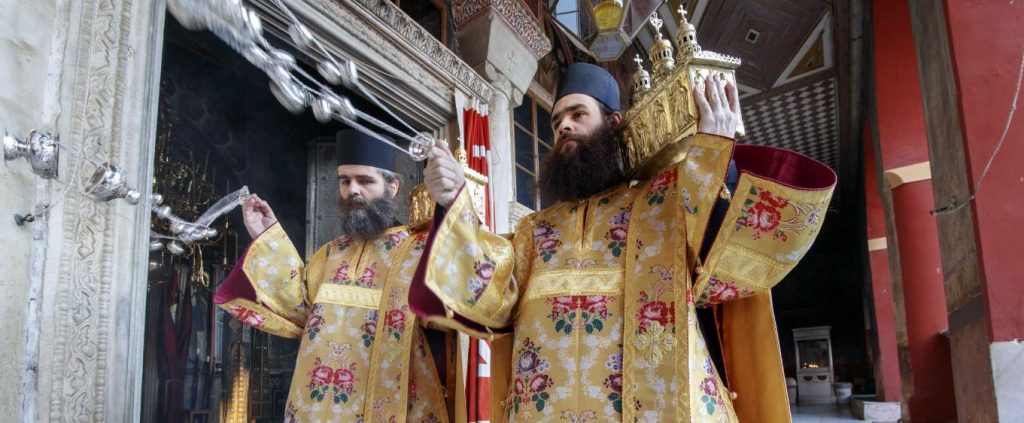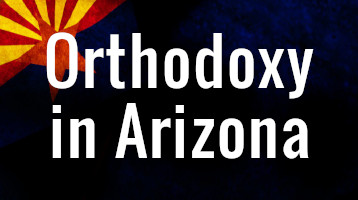
by Fr. Lawrence Farley
When was the last time you heard a sermon or read an article or blog post on Romans chapter 16? Apart from Rom. 16:1, which describes Phoebe as
“a diakonos of the church which is at Cenchrea” (the darling verse of those advocating the restoration of an order of deaconesses),
most people pretty much ignore the whole chapter, which consists largely of a list of names of people in the Roman church to whom Paul sends greetings. Greet Prisca and Aquila, greet Epaenetus, greet Mary, greet Andronicus and Junia, greet Ampliatus. The list goes on and on, and most people give it no more attention than they do names in a phone book. As far as most people are concerned, the Epistle to the Romans pretty much ends at the end of chapter 15.
That is unfortunate, for there is a hidden significance in all those names—namely that Paul knew of all those people and had enough of a relationship with them that he wanted to pass along his greetings. We see this concern for personal relationships throughout the New Testament. In his epistles to the Corinthians, Paul sends greetings, and bids them “greet one another with a holy kiss” (1 Cor. 16:20). In his epistle to the Philippians, he urges Euodia and Syntyche to live harmoniously (i.e. to stop fighting), and enlists the help of another person in the community there to make sure this happens (Phil. 4:2-3). In his epistle to the Colossians, Paul sends greetings to a number of people, and bids the Colossians greet the Christians in the neighbouring city of Laodicea (Col. 4:15). We see the same concern for personal relationships in the local Christian communities in the writings of John, for when he asks Gaius to greet the people in his community on John’s behalf, he says,
“greet the friends by name” (3 Jn. 14).
It is clear that these Christian churches were places where everyone knew everyone else, and had a relationship with them.
We see this personalism continuing in the church during those early centuries prior to the Peace of the Church. In those days when the Church was undergoing persecution, there was someone assigned to guard the doors. In the Didascalia Apostolorum, a church order or guide written about 230 A.D., we read,
“let another [deacon] stand outside by the door and observe them that come in” (2.57).
Obviously he was watching who came in because security was a great concern—the Christian Faith was then still highly illegal, and so a diaconal guard was posted by the door to make sure that only Christians entered and not the police. And this is the point: the diaconal guard knew all the people of the congregation. In fact, everyone in the congregation knew everyone else. As Gregory Dix says about this passage (in his Shape of the Liturgy), “people who are jointly risking at the least penal servitude for life by what they are doing generally make certain that they know their associates”. In the early church, the congregations were small and intimate enough that you could know the rest of the people in it.
When it comes to building authentic community then, size is important. The New Testament epistles presuppose such intimate communities and such personalism. The people in these local churches may not have lived in each other’s pockets as if the church were a commune, but it was enough of a family affair that they could know the other people there by name and have some sort of relationship with them. Not only was size important, but small, as they say, was beautiful.
This all started to change with the Constantinian revolution. After the persecution ceased and the Church began to have a privileged place in the Empire, larger churches started to be built, though of course not all church buildings were as massive as that of the Hagia Sophia. This was not wrong, and anyway was inevitable. The Church was being called by Constantine to exercise a public role in the world. If that Church was to have enough credibility to finish its task of converting the Empire, it needed all the trappings of an Empire. It needed educated and stately bishops as pastors. It needed a stately liturgy. And it needed some big buildings. Everyone was used to Religion having large temples, and if the Christian Religion was going to commend itself to society at large, it needed large temples too. And as Christianity became more popular, it would soon fill those temples.
It is just here that hindsight is so wonderful. From our present vantage point, we can see not only the advantages of having big buildings, but also the down side. The advantage, of course, is that a large church temple proclaims to all that the Church is The Place To Be. Many thousands can crowd into a single church building, and the size of the crowd itself makes a good argument for the truth of the Christian Faith. It is certainly much more encouraging to feel oneself part of such a large body than a small one (as Orthodox worshipping in tiny missions well know). But there is a down side to being part of a large church as well.
The downside is the loss of authentic relationship within that large body. In any mega-church, be it the ancient Hagia Sophia of Constantinople, the large Greek church downtown today with its 700 people on a Sunday morning, or even the huge Pentecostal assembly with its 1000 clapping worshippers, there is no way that a person there can know everyone else. One may be encouraged by seeing so many people, but one becomes a bit lost in the crowd. In large Orthodox churches today (I am thinking of some churches in Russia), one can have little or no relationship with the rest of the people worshipping there. That is no one’s fault; there are simply too many people to get to know. One does not feel part of a family, but part of a crowd. One can light candles there, and receive Holy Communion, but one does these things more or less anonymously. The personalism and family feeling witnessed to in the New Testament and present in the early church is no longer possible.
Byzantium casts a long shadow, and much of modern Orthodoxy lives in that shadow. We still treat our bishops as if they were Imperial dignitaries, even dressing them up in the Imperial sakkos (the robe worn by the Emperor) and the Imperial mitre (the crown worn by the Emperor). The diaconal exhortation at the Trisagion
“O Lord, save the Godfearing!”
is a prayer for God to save the Imperial Royal Family. Even in my own little St. Herman’s church, the processional cross still rises above a double-headed Byzantine eagle. Long shadows indeed.
But here in North America, we have a number of Orthodox churches which are less Imperial in their architecture and numbers, churches which can hold only a few hundred people, if that. That, I suggest, is no bad thing, for it allows us to recover the important personalism from the early church which was increasingly lost in the Church’s Byzantine period. We have the possibility once again of actually getting to know the fellow members of our local church community and of praying for them all by name. Church growth is good, and we are called to grow. But we must take care in our growth not to lose this personalism, which is so important to internal spiritual growth.
In particular, if a congregation grows to a size of about 200 people or so, they might consider splitting and founding another daughter church somewhere else (obviously with the bishop’s blessing), so that the local church never gets above 150 in number. Church growth gurus teach us that 150 is the maximum number in which authentic community can occur. In any church much bigger than that, it becomes hard to really know your fellow worshippers, and one fades into the anonymity of the mega-church. We have emerged from Byzantium, and are increasingly marginalized in our pluralistic North American society. That brings with it its own sorrows. But it also brings with it the possibility for recovering true community in our churches, and with it, a spirit of love.


